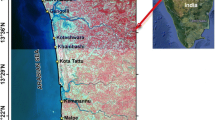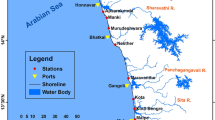Abstract
The presence of rhythmic beach cusps in foreshore regions are of persistent research interest to coastal researchers, engineers with respect to their formation in beaches. Morphometric and sediment analysis were used to study beach cusp morphology at Vengurla beach, a gentle slope beach characterized by medium sand. The cusp dimensions such as spacing, elevation, amplitude and depth were measured for detailed analysis. The distinctive sediment characteristics between the horn and the bays of the cusp are different and cusp measurements show a high level of irregularity. Horns and bays have medium sand, but sorting is varying. Sorting variations clearly demonstrated the difference in energy condition between horns and bay. Negative skewness of few horn samples has been correlated with erosional trend. Based on the grain size analysis result, it was observed that Vengurla beach cusps follow the regular grain size distribution pattern. Additionally, the low-intensity rip currents were also noticed in the study area. The rate of occurrence and strength of rip currents are decided by the nearshore bathymetry and play an imperative role in rip current formation. The present study is based upon the field measurements along Vengurla coast and contributes to morphometric analysis of beach cusps. Regarding beach cusps, there are no documented databases along the Indian coast. Understanding the beach cusp formation and its seasonal changes along the beaches will be useful for effective coastal management.








Similar content being viewed by others
References
Bagnold RA (1940) Beach formation by waves: some model experiments in a wave tank. J Inst Civ Eng 15:27–52
Blott SJ, Pye K (2001) GRADISTAT: a grain size distribution and statistics package for the analysis of unconsolidated sediments. Earth Surf Proc Land 26(11):1237–1248
Bowen AJ (1969) Rip currents, 1: theoretical investigations. J Geophys Res 74:5467–5478
Calvete DN, Dodd A, Falqués SM, van Leeuwen (2005) Morphological development of rip channel systems: normal and Near normal wave incidence. J Geophys Res. https://doi.org/10.1029/2004JC002803
Castelle B, Bonneton P, Dupuis H, Senechal N (2007) Double bar beach dynamics on the high-energy meso-macrotidalfrench Aquitanian coast: a review. Mar Geol 245:141–159
Chandramohan P, Kumar V, Jena B (1997) Rip current zones along beaches in Goa, West coast of India. J Waterway Port Coast Ocean Eng. https://doi.org/10.1061/(ASCE)0733 950×(1997)123:6(322),322-328
Ciriano Y, Coco G, Bryan K, Elgar S (2005) Field observations of infragravity motions in the swash zone and beach cusp evolution. J Geophys Res 110:C02018
Coco G, O’Hare TJ, Huntley DA (1999) Beach cusps: a comparison of data and theories for their formation. J Coast Res 15(3):741–749
Coco G, Huntley DA, O’Hare TJ (2001) Regularity and randomness in the formation of beach cusps. Mar Geol 178:1–9
Coco G, Burnet TK, Werner BT (2003) Test of self-organization in beach cusp formation. J Geophys Res 108(C3):3101
Dalrymple RA, MacMahan JH, Reniers AJHM, Nelko V (2011) Rip currents. Annu Rev Fluid Mech 43:551–581
Dean RG, Maurmeyer EM (1980) Beach cusps at Point Reyes and Drakes Bay beaches, California. In: Proceedings of the 17th international conference on coastal engineering. ASCE, pp. 863–884
Folk RL, Ward WC (1957) Brazos River Bar—a study in the significance of grain size parameters. J Sediment Petrol 27:3–26
Garnier R, Calvete D, Falqués A, Dodd N (2008) Modelling the formation and the long-term behaviour of rip channel systems from the deformation of a longshore bar. J Geophys Res 113:C07053
Gujar AR, Angusamy N, Rajamanickam GV (2008) Wave refraction patterns and their role in sediment redistribution along South Konkan, Maharashtra, India. Geo Acta 7:69–79
Guza RT, Inman DL (1975) Edge waves and beach cusps. J Geophys Res 80:2997–3012
Holland KT (1998) Beach cusp formation and spacings at Duck, USA. Cont Shelf Res 18(10):1081–1098
Holland KT, Holman RA (1996) Field observations of beach cusps and swash motions. Mar Geol 134:77–93
Holman RA, Stanley J (2007) The history and capabilities of Argus. Coast Eng 54:477–491
Inman DL, Guza RT (1982) The origin of swash cusps on beaches. Mar Geol 49:133–148
Komar PD (1973) Observations of beach cusps at Mono Lake, California. Geol Soc Am Bull 84(11):3593–3600
Kumar SA, Prasad KVSR (2014) Rip current-related fatalities in India: a new predictive risk scale for forecasting rip currents. Nat Hazards 70(1):313–335
Lopes V, Pais-Barbosa J, Taveira-Pinto F, Veloso-Gomes F (2011) Beach cusps: using multivariate data analysis techniques for the identification of important variables and for predicting their spacing. In: Furmanczyk K, Giza A, Terefenko P (eds) Proceedings of the international coastal symposium (Szczecin, Poland), Journal of Coastal Research, Special Issue No. 64, pp 1106–1110
Masselink G (1999) Alongshore variation in beach cusp morphology in a coastal embayment. Earth Surf Process Landf 24:335–347
Masselink G, Pattiaratchi CB (1998a) Morphodynamic impact of sea breeze activity on abeach with beach cusp morphology. J Coast Res 14:393–406
Masselink G, Pattiaratchi CB (1998b) Morphological evolution of beach cusp morphology and associated swash circulation patterns. Mar Geol 146:93–113
Masselink G, Short AD (1993) The effect of the tide range on beach morphodynamics: a conceptual model. J Coast Res 9:785–800
Masselink G, Hegge BJ, Pattiaratchi CB (1997) Beach cusps morphodynamics. Earth Surf Proc Land 22:1139–1155
Masselink G, Russell P, Coco G, Huntley D (2004) Test of edge wave forcing during the formation of rhythmic beach morphology. J Geophys Res 109:C06003
Masselink G, Kroon A, Davidson-Arnott RGD (2006) Morphodynamics of intertidal bars in wave-dominated coastal settings—a review. Geomorphology 73:33–49
Mukhopadhyay R, Karisiddaiah SM (2014) The Indian coastlines: processes and landforms. In: Kale VS (ed) Landscapes and landforms of India. Springer, Dordrecht, pp 91–105
Nishi R, Sato M (1991) Photographic observation on cusps and wave fields. In: Conference on coastal engineering. Japan society of civil engineers, Japan, pp 296–300
Nishi R, Sato M, Wang H (1994) Field observation and numerical simulation of dune and beach scarping. In: Proceedings of the 24th Coastal Engineering. ASCE, Conference, pp 2434–2448
Nolan TJ, Kirk RM, Shulmeister J (1999) Beach cusp morphology on sand and mixed sand and gravel beaches, South Island, New Zealand. Mar Geol 157:185–198
Ortega-Sánchez M, Losada MA, Baquerizo A (2003) On the development of large-scale features on a semi-reflective beach: Carchuna beach, southern Spain. Mar Geol 198:209–223
Otvos EG (1964) Observations of beach cusp and beach ridge formation on the Long Island Sound. J Sediment Pet 34:554–560
Pattiaratchi CB, Masselink G (1998) Formation and self-maintenance of beach cusps on anatural beach. In: Dronkers J, Scheffers M (eds) Physics of estuaries and coastal seas. Balkema Press, Leiden, pp 179–186
Sallenger AH (1979) Beach-cusp formations. Mar Geol 29:23–37
Seymour RJ, Aubrey DG (1985) Rhythmic beach cusp formation: a conceptual synthesis. Mar Geol 65(3–4):289–304
Shepard FP (1963) Submarine geology, 2nd edn. Harper and Row, New York
Shepard FP, Emery KO, Fond ECL (1941) Rip currents: a process of geological importance. J Geol 49:337–369, 1941
Short AD (1999) Handbook of beach and shoreface morphodynamics. Wiley, Chichester
Sonu CJ (1972) Field observations of nearshore circulation and meandering currents. J Geophys Res 77:3232–3247
Sunamura T (2004) A predictive relationship for the spacing of beach cusps in nature. Coast Eng 51:697–711
Vousdoukas MI, Kirupakaramoorthy T, de la Torre M, Wübbold F, Wagner W, Schimmels S, Oumeraci H (2014) The role of combined laser scanning and video techniques in monitoring wave-by-wave swash zone processes. Coast Eng 83:150–165
Werner BT, Fink TM (1993) Beach cusps as self-organized patterns. Science 260:968–971
Wright LD, Short AD (1984) Morphodynamic variability of surf zones and beaches: a synthesis. Mar Geol 56:93–118
Acknowledgements
Authors would like to thank the Secretary, Ministry of Earth Sciences, Government of India and the Director-NCCR for their encouragement, support and facilities provided to complete this research work. The authors thank the CP&SM team members for their contributions in field measurements and improvement of the manuscript. The authors are also thankful to the reviewers for their insightful comments and suggestions.
Author information
Authors and Affiliations
Corresponding author
Rights and permissions
About this article
Cite this article
Sathish, S., Kankara, R.S. & Rasheed, K. Morphometric and sediment analysis of beach cusp in correlation to rip currents: a case study from tropical coast, West coast of India. Environ Earth Sci 77, 578 (2018). https://doi.org/10.1007/s12665-018-7754-2
Received:
Accepted:
Published:
DOI: https://doi.org/10.1007/s12665-018-7754-2




